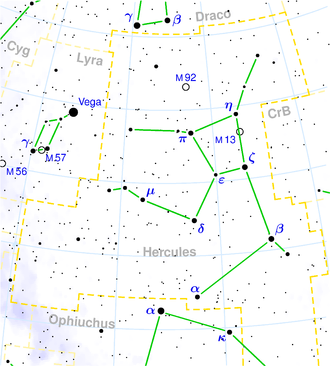NGC 6158
| Galaxy NGC 6158 |
|
|---|---|

|
|
| SDSS recording | |
| AladinLite | |
| Constellation | Hercules |
|
Position equinox : J2000.0 , epoch : J2000.0 |
|
| Right ascension | 16 h 27 m 40.9 s |
| declination | + 39 ° 22 ′ 59 ″ |
| Appearance | |
| Morphological type | E-S0 |
| Brightness (visual) | 13.8 mag |
| Brightness (B-band) | 14.8 mag |
| Angular expansion | 0.9 ′ × 0.6 ′ |
| Position angle | 81 ° |
| Surface brightness | 13.2 mag / arcmin² |
| Physical data | |
| Affiliation | Abell 2199 |
| Redshift | 0.029954 ± 0.000022 |
| Radial velocity | 8980 ± 7 km / s |
|
Stroke distance v rad / H 0 |
(408 ± 29) x 10 6 ly (125.2 ± 8.8) Mpc |
| history | |
| discovery | Wilhelm Herschel |
| Discovery date | March 17, 1787 |
| Catalog names | |
| NGC 6158 • PGC 58198 • CGCG 224-031 • MCG + 07-34-041 • 2MASX J16274088 + 3922588 • GC 4205 • H II 647 • NSA 147002 • LDCE 1190 NED014 • HOLM 749A | |
NGC 6158 is a 13.8 mag bright, elliptical galaxy of the Hubble type E / S0 in the constellation Hercules in the northern sky . It is estimated to be 408 million light years from the Milky Way and about 110,000 light years in diameter.
In the same area of the sky is u. a. the galaxy NGC 6166 .
The object was discovered on March 17, 1787 by Wilhelm Herschel with an 18.7-inch reflector telescope, which she labeled “F, S, iF. The time inaccurate “described.
